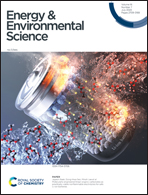Tuning the product selectivity of CO2/H2O co-electrolysis using CeO2-modified proton-conducting electrolysis cells†
Abstract
Co-electrolysis of CO2 and H2O to produce fuels using proton-conducting electrolysis cells (PCECs) is a promising technology for effective CO2 utilization. The direct production of hydrocarbon fuels using PCECs, nevertheless, remains challenging, and the mechanism of CO2 hydrogenation during electrolysis is still unclear. Here, we demonstrate surface engineering as an effective strategy for promoting the CO2/H2O co-electrolysis to produce CH4 using PCECs. A thin CeO2 layer is impregnated selectively onto the BaCe0.7Zr0.1Y0.1Yb0.1O3−δ (BZCYYb) surface of a Ni-BZCYYb fuel electrode. The PCEC with a CeO2-modified electrode exhibited more than 3 times CH4 selectivity at 550 °C and 1250 mA cm−2 than the cell with a pristine electrode. The combination of advanced spectroscopic techniques and density functional theory calculations demonstrates that the decorated CeO2 modulates the adsorption of reactants and facilitates proton transfer for the hydrogenation process, leading to accelerated CH4 production. The result provides critical insight into the rational design of high-performance catalysts for other high temperature electrochemical devices.



 Please wait while we load your content...
Please wait while we load your content...